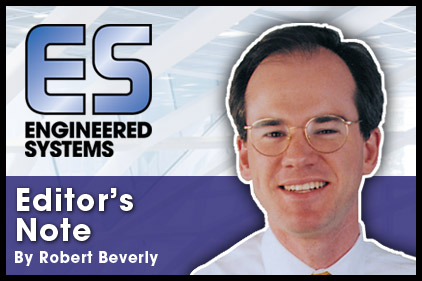We’ve got something cool that is a little out of the ordinary this month, so I’m going to hand over the bulk of the page to ES authors Robert Bolin, P.E., HBDP, LEED Fellow; and Andrew Reilman, P.E., HBDP, LEED AP BD+C. Bolin is a Senior Vice President and National Director of High Performance Solutions for Syska Hennessy Group, based in their Chicago office. Meanwhile, Reilman is an Associate Partner and Regional High Performance resource for the firm, located in its Los Angeles office.
These engineers have some followup to their recent reader challenge, and I’ll let them fill in the details.
In the May issue’s feature article, “Calculated Conditioning: The IAQ Of UFAD,” the authors described multiple benefits provided by these systems, such as improved thermal comfort and improved IAQ that result in improved productivity and health. There is also the reduced lifecycle cost afforded by reduced building heights and operational energy use reductions typically enabled by increased economizer hours.
However, this system choice also brings some challenges as well. Careful consideration must be given to humidity control when implementing a system with elevated supply air temperatures. This applies both for typical occupant comfort and for sensitive finishes within the built environment. The authors presented five alternative system configurations to control supply air humidity at elevated temperatures.
Related to those alternatives, the authors posed a challenge to the reader: How would you rank the alternative configurations of re-heat for dehumidification of comfort cooling for a typical office occupancy using UFAD or displacement ventilation in a Chicago climate?
The authors’ ranking below is based on a 5-story, 100,000-sq-ft office building located in Chicago. The water-cooled centrifugal chiller plant, heating-hot water boiler plant, windows, walls, roof and lighting power density are assumed to be compliant with the AHSRAE 90.1-2007 prescriptive minimum performance. To simulate the alternatives, the authors employed building performance simulation software. The alternative configurations required post-processing approximations to perform the simulations.
Ranking from least energy usage to most energy usage:
- Wrap-around heat pipe (39% less heating / cooling energy than cooling coil with hydronic reheat)
- Face and by-pass dampers (31% less heating / cooling energy than cooling coil with hydronic reheat)
- Runaround heat recovery for reheat (19% less heating / cooling energy than cooling coil with hydronic reheat)
- Cooling coil with downstream hydronic reheat
ONLINE EXCLUSIVE: BAS ON CAMPUS
By the time you read this, we should have an illustration-rich bonus feature waiting for you on the ES website, contributed by Albena Iossifova and Scott Albert of Slippery Rock University. The quick snapshot:
Using Control Charts to Monitor the Room Temperature
In this tale of setpoint sleuthing, the team at Slippery Rock University digs hard into the data to see why and where the old BAS strategy was going wrong. See what the measurements and math turned up for various spaces in terms of culprits and recommendations.
Check out that extra college/university content when you can, and we’ll see you next month.
ES WEBINARS
Here are just a few of the topics in our webinar archives at
- Chilled Beams
- Heat Recovery
- VRF
- Boiler Rules
- Heat Pipe Systems
- Firetube Boilers
- Enthalpy Wheels
July 30
Seizing Power: A New Market For Combined Heat & Power (CHP)
Presented by John Seryak, P.E. of Go Sustainable Energy
Sponsored by Kohler Power Systems.





